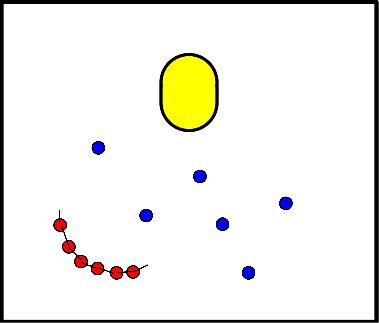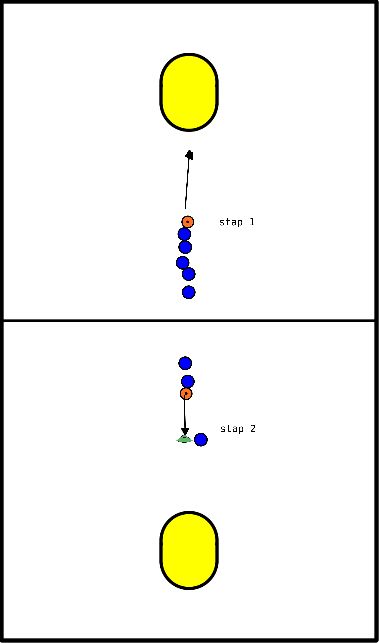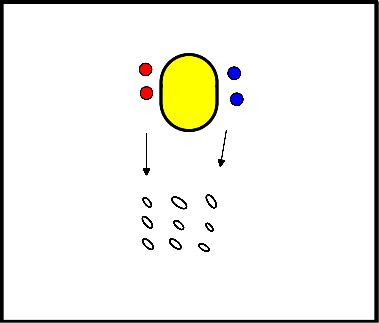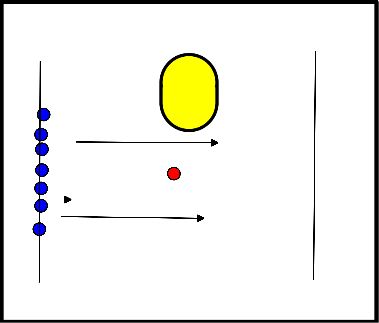Korfball exercises for u7
- One ball per pair/three.
- Players throw across until they reach a pole.
- At the pole, both players may shoot once.
- Then they must again throw over to another pole.
- All groups just go right through each other.
- Whichever two/three has 15 goals (optional) first.
- 3 groups at pawns
- Run to the hoop
- Through there, through to pawns
- walk across footbridge
- jumping over stick
- Finally shoot (2 attempts)
- Whoever scores 5 times first (collect pawns)
- One ball per pair/three.
- Players throw across until they reach a pole.
- At the pole, both players may shoot once.
- Then they must again throw over to another pole.
- All groups just go right through each other.
- Whichever two/three has 15 goals (optional) first.
The chaos game is fun for younger children, but can also be played with older ones.
- In the chaos game, the idea is for each child to have a ball, and 3 to 4 poles (also depending on the number of players)
- Line up in a row.
- Each player starts at the same pole,
- There is a countdown and then they all start shooting,
- If they score, they move up one pole,
- If they don't score, they stay at the post until they do.
- You can agree in advance whether they have to pass each pole 1, 2 or 3 times depending on the level.
- Variation: you can use pawns to mark a circle outside of which the players must shoot,
- They may enter it only to catch the ball.
- Materials below are for 4 people (hat = pawn)
- 1 person is the ticker
- The ticker is going to try to tickle as many people as possible, ticked? Then hold each other's hands until the pendulum is very long!
Red dots are the tickers. They are not allowed to let go of each other. The blue dots are the people who have yet to be tapped.

- Make pairs
- Place 3 pawns in a triangle, about 4 meters apart
- Players stand at pawns 1 and 3
- Player at pawn 1 has a ball
Progression:
- Player at pion 3 runs to pion 2 taps him and runs back.
- The player at pion 1 throws the ball before player 2 arrives at the pion, so that the ball is given in the run.
- When the ball arrives at player 2 then player 1 at pion 1 runs to pion 2 and the player at pion 1 runs to pion 2 and back.
- Gets the ball passed in the run when she/he arrives at pion 1 again.
- Then player 2 starts again.
More difficult:
Throwing with the other hand.
Variation:
Throwing with the other hand.
Variation:
- player 1 at pawn 1 and player 2 at pawn 3.
- player 1 runs to pawn 2 and player 2 throws the ball in the run to player 1.
- After throwing the ball, player 2 runs directly to pawn 1 and receives the ball in the run from player 1.
- Player 1 then runs towards the free pawn again and so on.
- When the trainer calls yes, the players turn the other way.
- Make sure they keep throwing with the outside hand.
- Put 3 pawns in a triangle, with about 4 meters apart
- At pawns 1 and 3, one person stands.
- The player at pawn 1 has the ball.
- The player at pion 3 runs to pion 2, taps it and runs back.
- The player at pawn 1 throws the ball to player 2 before he is back at the 3rd pawn.
- Thus the ball is given in the run.
- When the ball arrives at player 2, player 1 then runs to pawn 2 and back again in which he then gets the ball passed by player 2 in the run.
- Shot game in 2-team form. Playing against the other baskets.
- One of the two will shoot. If 2x is scored you call out to the coach.
- If you are the fastest, you have won and on all baskets the pairs are changed.
- The one who finishes first has earned a point.
- The other of the pair catches the ball.
- If the ball bounces on the ground then a goal goes off.
- Variation possible through through balls and off movement.
- Pay attention to the passing. Where does someone want the ball when you pass?
- Out of motion: keep moving after your shot to receive the ball. You keep running until you receive the ball again.
Place at least half the number of players participating in baskets distributed in a circle on field.
- One player stands under each basket with ball
- The remaining players stand in the middle between the lined up baskets
- Have players walk to a basket and pull a hook and then shoot.
- If the ball is in, on a regular basket, the player gets 1 point.
- Is the ball in, on a shooter's basket, then you get 2 points.
- If the player has scored, he walks to the center and chooses another basket to shoot at.
- If the player did not score, then you switch with the passer.
- Play like this to a self-selected number of points.
variation:
- follow-through
- pull away ball
Step 1:
Each player has their own ball and lines up in a line with other players in a row 6 meters in front of the basket.
The first player in line runs toward the basket and takes a penalty throw with a quick motion. Runs back and joins the back of the line. The next player starts.
Each player has their own ball and lines up in a line with other players in a row 6 meters in front of the basket.
The first player in line runs toward the basket and takes a penalty throw with a quick motion. Runs back and joins the back of the line. The next player starts.
Step 2:
Same setup as step 1. Only now a player also stands in support, slightly in front of the penalty throw spot. This one puts the ball on 1 hand. The runner approaches, grabs the ball from the hand and takes a penalty throw.
Step 3:
Same as step 2. Only the declarer throws the ball up a little.

- You lay down 9 hoops or baskets in a square.
- You divide the team into 2 groups and have them start from a number of meters.
- Here they are given 3 pawns.
- The children must walk to the hoops and place their given pawn in one of the hoops to get butter cheese and eggs.
- When all the pawns have been used up they must move the pawns.

- Players line up on one side, in the middle a skipper.
- The skipper gets to decide how the players cross over to the other side.
- For example, in a frog jump or hopping.
- Everyone does this including the skipper.
- The skipper tries to tap as many children as possible.
You as the trainer start as the first skipper to set the example.









